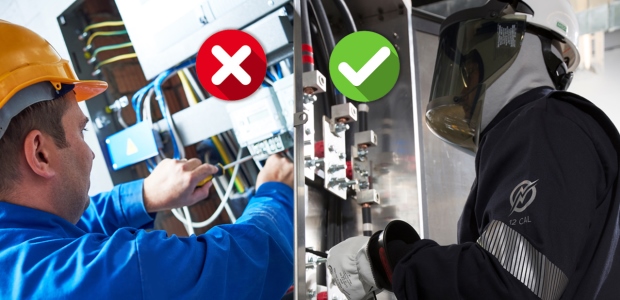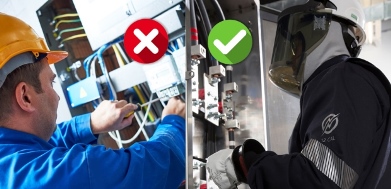
Creating an Electrical Safety Culture: The Dangers of Complacency
Complacency can be dangerous when it comes to protecting the face and hands or properly protecting yourself from devastating electrical shock hazards.
- By Mike Enright
- Mar 01, 2019
Are your employees fully protected from electrical hazards, even when they're working on "small" and/or "quick" electrical tasks? Many workers often think, "I'm wearing my arc-rated FR shirt and pants, so my PPE needs are covered." If your company has installed arc-rated FR daily wear clothing, your electrical safety program is on a good path.
However, it's critical to understand that, although you're on a good path, you still may be only halfway there. It's also important to make sure your workforce understands that they're still not ready to work on or near live electrical equipment until they don other important PPE to protect their head and face, as well as rubber electrical gloves and leather protectors to protect against shock.
The Dangers of Complacency
We've talked with many electrical safety professionals over the years, and most agree that complacency can set in after programs are installed. When this happens, the step of donning additional PPE can get skipped for "small" and/or "quick" electrical tasks.
1. Partially Covered Isn't Fully Protected
This reminds me of the first "real" car I bought after college. It was a 1991 Mercury Cougar that had a convenient new, and now extinct, feature—automatic seat belts. You may remember these but for those born in the '80s or later, I'll briefly explain. When you entered the front seat of a car (driver or passenger), the cross-chest belt, which was mounted to the top front of the door frame near the windshield, would move via motor around the door frame until it rested behind and above your shoulder. This would draw the belt across the chest of the passenger. It was still the duty of the driver and passenger, though, to secure the lap belt.
Without the lap belt in place, a cross-chest belt by itself might provide some protection in an accident, but without the lap belt you could still get badly injured. I must confess, while I "usually" connected the lap belt, I avoided it on some "quick" trips, thinking, "I'm mostly protected as soon as I sit down." In hindsight, that was a bad decision, and this convenient "safety" feature disappeared in cars forever in just a couple of years because it didn't effectively keep people safe.

While the worker on the left may be wearing arc-rated FR daily wear, he is still not fully protected. The worker on the right is fully protected for the electrical tasks he's working on. (Enespro PPE photos)
2. A Step in the Right Direction
Clearly, wearing arc-rated FR daily wear will provide significantly more protection than non-FR clothing. In fact, arc-rated FR clothing could be the difference between life and death, as the majority of fatalities from arc flashes result from clothing ignition and not from the arc flash itself.
Just as with automatic seat belts, complacency can creep into arc-rated clothing programs. "I'm already largely protected, so I'll just do this quick task without temporarily putting on my balaclava, arc-rated faceshield, or electrical gloves" is something we still hear routinely today.
This complacency can be dangerous when it comes to protecting the face and hands or properly protecting yourself from devastating electrical shock hazards.
Developing a PPE Program and Creating a Culture of Safety
In addition to an arc-rated daily FR program, there is another good alternative path you can take leading you to the same protection.
1. Task-Based and Daily Wear: Both Can Provide a Path to Safety
In a "daily wear" program, workers would already be wearing arc-rated FR clothing (usually a CAT 2 shirt/pant or coverall combination). However, before they start a task, they still need to ensure the arc rating is adequate for the job, and they must add the other important PPE, which includes a balaclava, faceshield/hard hat, ear plugs, safety glasses, and voltage-rated rubber gloves and leather protectors.
The other option is implementing a "task-based" program, in which workers bring a full PPE kit that includes all of their electrical safety PPE needs with them in a gear bag. When workers are faced with an electrical task, they would quickly put on the appropriate level arc flash suit over their clothing along with a balaclava, faceshield/hard hat, ear plugs, safety glasses, and voltage-rated rubber gloves and leather protectors.
The criticism of task-based programs is typically focused on the concern that workers might skip the step of donning the arc-rated suits to do some "small" and/or "quick" electrical tasks (sound familiar?). This is a legitimate concern but it's important to understand that going with a daily wear program does not eliminate this concern of taking shortcuts when it comes to protecting your head, face, and hands as well as insulating workers from electrical shock.
2. Stop, Think, Select the Proper PPE
Regardless of whether you've implemented a task-based or daily wear PPE program, it's important for everyone to understand that they need to stop and think about what PPE is required before they do any tasks. While daily wear could save a few minutes, the fact remains that this step needs to take place regardless of what they're wearing when they walk out their door in the morning.
Furthermore, if your workers are only doing a handful of electrical tasks each week, task-based programs may actually be a better fit for you. Conversely, if they are doing work that requires PPE multiple times a day, an arc-rated daily wear program may be the best solution for your company.
Innovations Make Daily Wear and, More Recently, Task-Based Programs Easier
Fortunately, there has been a tremendous amount of progress and innovation to advance arc flash safety. It's amazing to compare the arc-rated FR daily wear from 10-15 years ago to the options that exist today.
These advancements, specifically in the area of comfort, have been a key factor in moving hundreds of thousands of electrical workers into arc-rated clothing. Arc-rated daily wear has made dramatic strides in the past decade, and there are finally some new products in the task-based market with dramatically improved comfort and mobility that are much easier to don and doff.
Many Paths to One Goal—Safety
We've all heard the statistics about electrical hazards and it's important to recognize that complacency and human error still exist, so processes should be put in place to ensure full body protection from electrical hazards. At the end of the day, there is no "right" way to comply with NFPA 70E to keep your workers safe, and you should take the path that best fits your specific needs. The goal is always to make sure you select the best solution and PPE products for your company so your workers go back home to their families in the same condition they came to work.
This article originally appeared in the March 2019 issue of Occupational Health & Safety.